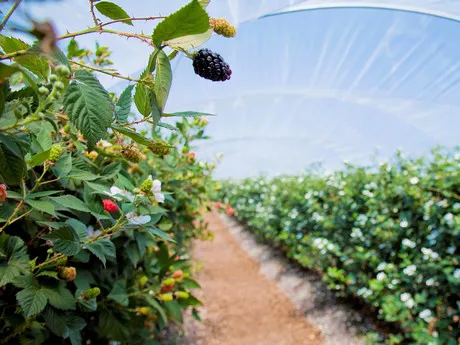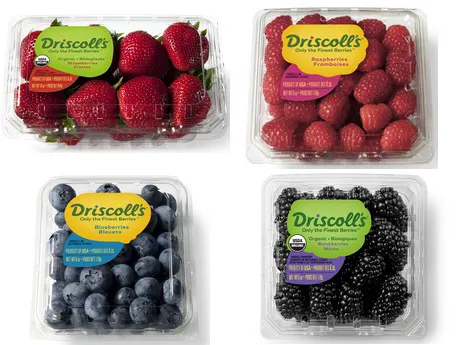Recently, the Florida Strawberry Growers Association (FSGA) expressed concerns that Florida growers are facing decreasing prices for their strawberries. The reason? According to the Association, there has been a substantial increase in the volume of berries imported from central Mexico, meaning Mexico now produces 60 percent more strawberries than Florida. The FSGA claims that this has forced Florida growers to lower prices to maintain a share of the market and is subsequently seeking greater protections from the Government.
However, berry grower Driscoll's says this is not the solution and will only result in a negative impact on consumers. The company has year-round strawberry production spanning across North America, including both Mexico and Florida. Soren Bjorn, Driscoll’s President of the Americas, says the claims made by the FSGA are incorrect.
"The general idea that Mexico ships cheap berries is simply not correct," he explained. "In fact, over the past five years, we have seen higher prices out of Mexico. The other claim that Florida growers are not making money is also false. On the contrary, the Florida region has been one of the most consistently profitable strawberry growing regions in North America. We do understand where these claims are coming from, but as a year-round shipper in all berry growing regions, we just don't see it."

Driscoll's Soren Bjorn says innovation is the answer, not protectionism
Focus should be on strong berry category
One of the major arguments that Driscoll's puts forward is that whatever happens in the strawberry and broader fresh berry industry should be beneficial to the consumer. Bjorn says a strong strawberry industry is in the interests of everyone, including consumers and berry growers. Therefore, instead of creating divisions, the industry should work together to further strengthen the berry category.
"Berries are the biggest fruit category by revenue in North America," Bjorn observed. "The fact that we have year-round availability is one of the reasons for this. Florida can be erratic at times because they grow strawberries in the winter and can be impacted by rain and cool weather. When supplies are erratic, it's more difficult to establish a strong market. When there is more stability, retailers are more willing to put out displays and offer promotions, and consumers can enjoy fresh strawberries at any time of the year. This is why both Mexico and Florida can and should complement one another during the winter season."
Innovation the key - not protectionism
Rather than relying on regulation of the industry, Driscoll's is encouraging Florida growers to work to their strengths and continue on the path of innovation. According to Bjorn, this has already been demonstrated by the success of the "Florida Brilliance" strawberry variety. "It's a great variety, it's good eating and it attracts more consumers," he said.
Labor is a major obstacle to the competitiveness of Florida's strawberry industry. Driscoll's acknowledges it's one area where Mexican producers have a cost advantage. However, technology and improved farming practices are ways in which Florida is rising up to the challenge, and it's already being implemented.

"We have seen the development of a robotic harvester, led by Gary Wishnatzki, which will ease labor pressure," Bjorn shared. "We have also developed better methods to help protect crops from adverse weather, as is the case with blueberries where many of the farms now grow them under cover."
"Improving yields is another area where Florida growers really need to look at themselves and see where they can improve," he continued. "The reality is that the average yield for blueberry growers in Florida is lower than what the global benchmark is now. But even here we are seeing innovation leading the way with different varieties being introduced that we predict will substantially improve yields. The bottom line is that Florida should be asking help for more innovation, not protection. Protectionism will only lead to becoming less relevant, which would be devastating for the berry industry."
Florida and Mexico each have advantages
Another way in which Mexico and Florida strawberry industries can work together is by capitalizing on their respective strengths. Bjorn highlighted some of the advantages that Florida growers have. These include the proximity to markets, especially on the East Coast. "When you're dealing with a perishable commodity such as strawberries, a few days can make a big difference," he said.
The fact that Florida growers have been growing strawberries for longer than their Mexican counterparts also provides some advantage. "We have been trying to adapt strawberry growing in Florida for much longer than in Mexico," Bjorn expressed. "Additionally, the sandy soil in Florida lends itself well to growing strawberries."

Aside from the cost advantage, Mexico also tends to have more stable weather in the winter season, when the two regions are in production. Again, this is something Bjorn wants to see punctuated as to why both regions should work together. "California still grows the majority of strawberries in North America," he explained. "But they can't grow them in winter. So Florida and Mexico need to complement one another to ensure good year-round supply. In the future, we see them as growing more complimentary. With the Florida Brilliance variety, we are seeing Florida's season moving earlier in the year. Meanwhile, Mexico's strawberry season has been edging later - and beyond Florida's traditional window - because of better growing practices."
Driscoll's now in peak season in California
Currently, both Mexico and Florida have passed their strawberry seasons and the focus is on California. For Driscoll's, the next few months represents the company's peak strawberry season in California. There is a feeling of optimism as crop yield and quality are looking good, and expectations are for the season to be smoother than it was last year.
"Driscoll's is now moving into its 'traditional' strawberry season through May and June," Bjorn shared. "During these months, we see a long and strong peak in California and this year we are seeing excellent quality berries so far. The market should be more orderly this year, in contrast to last year when weather conditions resulted in much of the volume coming on all at once. We are really looking forward to the next two months."
For more information:
Driscoll's
press@driscolls.com
www.driscolls.com
